Lawns
Plant Health Problems
Diseases caused by Fungi:
Rhizoctonia brown patch, Rhizoctonia solani.
Symptoms of this common turf disease appear as circular to irregular patches of poorly growing grass which eventually turn brown. Individual blades of infected grass have purple-brown, irregular lesions. Affected areas appear sunken when disease is severe. These patches can vary in size although disease development can be rapid when weather is favorable. The fungus attacks the roots, first killing the fine feeder roots and then the entire root system. This is a disease of hot, humid weather and is more pronounced on lawns that are heavily fertilized and frequently watered. Brown patch is most severe in perennial ryegrass and tall fescue lawns.
Control strategies include following a well-balanced fertilization program which minimizes excessive applications of nitrogen before hot weather and watering practices which promote rapid drying of the leaf blades (early morning). Resistant or tolerant cultivars of turfgrass are available. Chemical control can supplement other methods for disease management during periods of humid hot weather. However, they are usually not necessary on Kentucky bluegrass or fine fescue lawns. Among the compounds registered for use in Connecticut are chlorothalonil and iprodione. Consult the label for dosage rates and safety precautions.
Snow molds, gray and pink, Typhula, Fusarium.
The fungi that cause these diseases attack the grass during the winter, either under snowcover or during cold winter rains. The injury shows in the spring as irregular spots of dead, matted grass. Grass infected with pink snow mold appears white to salmon in color whereas infections by gray snow mold appear white to gray. Gray snow mold usually attacks leaf blades whereas pink snow mold may invade the roots and crown tissues. In most cases, the grass will recover during warm spring weather. Factors that promote disease development include late fall fertilization, snowcover before the ground freezes, and matted leaves. Kentucky bluegrass and fescue lawns are the least susceptible to severe damage although all lawn grasses can be infected.
The effects of these diseases can be minimized by raking the affected patches to remove plant debris and to stimulate new growth in the spring. Over-seeding is also helpful. No other control measures are usually necessary.
Dollar spot, Sclerotinia homoeocarpa.
This disease is characterized by small circular brown spots on the leaf blades which can turn nearly white. The spots may remain separate or coalesce into larger irregular areas which often have hourglass shapes. Dollar spot can occur in the early summer, late summer, and early fall when there is high humidity and cool nights follow warm days. All turfgrasses are susceptible to this disease although Kentucky bluegrasses are relatively resistant.
It is helpful to maintain adequate fertility since dollar spot is often found on nitrogen-deficient lawns. Infected lawns should be mowed when the grass is dry to minimize spread of the fungus to healthy grass. Watering to maximize vigor is helpful but it should be deep rather than frequent, shallow watering. Chemical control can supplement other methods for disease management during periods of humid weather although they are usually not necessary. Among the compounds registered for use in Connecticut are chlorothalonil, iprodione, and thiophanate-methyl. Consult the label for dosage rates and safety precautions.
Red thread, Laetisaria fuciformis.
Infected lawns frequently have a reddish-pink cast in early morning or when wet. These colorful patches can vary in size from several inches to several feet in diameter. When examined more closely, the symptomatic grass blades appear to be covered with a pinkish, gelatinous growth when the grass is wet or pink, cotton candy-like threads when the grass is dry. Infected grass blades may turn brown, but infection is usually limited to the blades. Red thread is most common on perennial ryegrasses and fine leaf fescues although it can occur on most turfgrasses.
This disease is usually more common on lawns that are stressed by drought, soil compaction, low temperatures or inadequate fertility so any steps to minimize stress and maximize vigor are helpful. Watering should be infrequent but deep. Although chemical controls for this disease are usually not necessary, fungicide sprays can supplement other methods for disease management. Among the compounds registered for use in Connecticut are thiram, iprodione, and triadimefon. Consult the label for dosage rates and safety precautions.
Anthracnose, leaf spots, melting-out, Drechslera, Bipolaris, Ascochyta.
These diseases are commonly found after periods of extended wet weather and can occur under a variety of temperatures. Symptoms vary from small red to purple spots on leaf blades to tip blights and to total plant collapse, depending upon the particular fungus involved. Large, weakened patches of turf may result. These diseases are so common that they probably occur in every home lawn although they usually don't result in substantial damage unless the lawn is weak from low fertility or from other stresses.
Although these diseases aren't considered a threat to the overall health of a lawn, steps to maximize vigor are helpful. Among these are: following an adequate fertility program, deep watering, mowing when the blades are dry, and re-seeding with cultivars that are resistant. In most situations, chemical controls are not necessary. However, fungicide sprays can supplement other methods for disease management. Among the compounds registered for use in Connecticut are chlorothalonil and iprodione. Consult the label for dosage rates and safety precautions.
Pythium blight or Greasy spot, Pythium spp.
This disease is a problem of hot, humid weather when night temperatures are high. Symptoms first appear as small, slimy, "greasy" spots in the lawn. These spots can vary in size and are often covered with a white, cottony web when the grass is wet. Disease can spread rapidly if hot, humid weather persists and in areas where drainage is a problem. Infection of perennial ryegrass lawns is most common.
Although weather is an important factor for disease development, steps to improve drainage, to promote drying of leaf blades (by watering early in the day), and to provide adequate fertility are helpful. It is also important to avoid mowing when the grass is wet. Fungicide sprays can supplement other methods for disease management. Among the compounds registered for use in Connecticut are etridiazaole and metalaxyl. Consult the label for dosage rates and safety precautions.
Necrotic ring spot and summer patch, Leptosphaeria, Magnaporthe.
These diseases have very similar symptoms and, as the names suggest, appear as dead patches in the lawn. These patches are usually circular although this pattern can be masked once the individual patches coalesce. Symptoms are most obvious in warm, hot weather, particularly when the grass is drought-stressed. Areas along sidewalks and roadways are often the first to show symptoms since they are particularly prone to heat- and drought-stress. The fungi causing these diseases attack the roots and crowns of grasses; these infected tissues often appear brown or black and rotted. These diseases are most severe on Kentucky bluegrasses and fine-leaf fescues. Perennial ryegrasses are not very susceptible.
Strategies which maximize plant vigor are most helpful to minimize the damage associated with these root diseases. This includes following a sound program for cultural care (fertilizing, watering, thatch removal). Additionally, planting and/or over-seeding with resistant cultivars are also effective and will help to mask damaged areas. Chemical controls are not very effective and are usually disappointing because of the root damage associated with these diseases. Since most fungicides don't have curative properties, the damage cannot usually be reversed.
Rusts, Puccinia spp.
These diseases usually develop in late summer and early fall and are most common on Kentucky bluegrass and perennial ryegrass. Early infections appear as light yellow flecks on the grass blades. These flecks enlarge in rows which are parallel to the veins of the leaves. The development of the fungus within the leaf causes the cuticle and epidermis of the leaf to rupture and reveal the rusty-orange colored spores for which these diseases get their name. When infections are heavy, enough spores are present to leave a reddish dust on shoes, mowers, and any objects that come in contact with the infected leaves. Leaf blades may dry and wither due to splitting of the epidermis and subsequent loss of moisture associated with those splits. Rust-infected turf is weak and more susceptible to other stresses such as drought and winter injury. The disease cycle for rusts is complex and, in Connecticut, most infections result from spores blown here from southern states. Free water on the grass blades is also necessary for infection.
Control strategies include following a well-balanced fertilization program to maximize the vigor of the grass. Resistant or tolerant cultivars of turfgrasses are available. It is also important to avoid wetting the grass blades. Frequent mowing is helpful to remove infected leaves before spores are released. Chemical control is usually not necessary but can supplement other methods for disease management in extreme cases. Among the compounds registered for use in Connecticut are chlorothalonil, triadimefon, and propiconazole. Consult the label for dosage rates and safety precautions.
Diseases caused by Physiological/Environmental Factors:
Moss.
The appearance of moss in a lawn can be associated with a number of factors including problems with turfgrass management and/or soil and site characteristics. Mosses are small plants that can grow and out-compete turfgrass species when one or more of the following occur: high soil acidity (low soil pH), low soil fertility, shade, poor soil drainage, and soil compaction.
The first step in controlling moss in a lawn is to determine the nutritional status and pH of the soil so that fertilizer and lime applications can be made to correct any deficiencies. Heavy or compacted soils can be improved by incorporating several inches of sand and/or composted leaves or organic matter into the soil and by aeration. These amendments may help to improve both soil texture and drainage. Hand raking can be effective for eradicating moss. However, control may only be temporary if the reason(s) for the infestation is not established or remedied as previously described. Moss can also be controlled through the use of chemicals. Since moss grows most strongly during cool moist conditions in the fall and spring, these are the best times for applying chemical moss killers. Among the compounds registered for use in Connecticut are potassium salts of fatty acids and iron sulfate. Consult the label for dosage rates and safety precautions. The treated area should be thoroughly watered 48 hours after the application in the absence of natural rainfall. Once the moss blackens and dies, it will need to be thoroughly raked. For more information, see the fact sheet on moss control in Home Lawns.
Algae.
The green to black, slimy growth often found in damp shady places in the lawn is actually a mass of small, green plants called algae. Algae do not harm the grass but can be unsightly and are often indicative of soil moisture problems. Algae often grow under conditions of high soil acidity (low soil pH), low soil fertility, shade, poor soil drainage, and soil compaction.
Efforts to improve the site and soil are important to eliminate the growth of these plants. The first step in controlling algae in a lawn is to determine the nutritional status and pH of the soil so that fertilizer and lime applications can be made to correct any deficiencies. Heavy or compacted soils can be improved by incorporating several inches of sand and/or composted leaves or organic matter into the soil and by aeration. These amendments may help to improve both soil texture and drainage. Once these conditions have been modified, reseeding can be done, preferably with turfgrasses which are shade-tolerant.
Thatch.
Thatch is a normal component of healthy turf which consists of living and dead stems, leaves, and roots. It appears as a layer between the actively growing grass and the underlying soil. Thatch develops as a result of many factors including the naturally vigorous growth of Kentucky bluegrasses, fertilizer deficiencies, acidic soils, and overwatering. Thatch becomes a problem when it accumulates to an excessively thick layer which restricts the movement of air, water, and fertilizer to the grass roots. Contrary to popular belief, thatch does not result when clippings are left on the lawn after cutting. Turf with excessive thatch (greater than approx. 1-1/2 inches thick) can appear weak and does not respond to management practices such as fertilizing. The presence of excessive thatch can be determined by cutting a small wedge of turf several inches deep. If the spongy thatch layer is greater than 1-1/2 inches, it is considered excessive.
Thatch buildup can be prevented by following good cultural practices such as deep watering, a well-balanced program for fertilizing and liming, and other practices that promote the activity of microbes and earthworms in the soil. However, if excessive thatch is found, grass can be mechanically reduced using dethatchers, also known as vertical mowers, verticutters, and power rakes. Dethatching is best done in late summer or early fall when turf recovers most quickly.
Mushrooms, various fungi.
The appearance of mushrooms or "toadstools" in the lawn usually follows periods of rainy weather in the spring, summer, or fall. It is not uncommon for these fruiting bodies to pop up overnight. Mushrooms are the above-ground, reproductive structures of a number of fungi which grow unnoticed for most of the year on decaying organic matter in the soil. In lawns, this frequently consists of buried stumps, old wood from construction projects, or decaying tree roots. Mushrooms are chiefly considered a nuisance since they do no harm to the grass. However, they can present a problem for children or pets since some types of mushrooms are poisonous if eaten.
Mushrooms can be removed by frequent raking or sweeping although diligence is often necessary since new mushrooms can often appear overnight, especially during wet weather. Fungicides are not effective for control of these types of fungi.
Slime molds
There are several types of slime molds that appear in lawns during warm, damp weather. One of these molds appears as a bluish-gray, sooty growth on the grass, the other looks like a large, unpleasant, dirty-yellow mass. Neither of these organisms do any harm to the grass since they are simply using the blades of the grass as a structure upon which to grow. Slime molds are not pathogenic, do not infect turfgrasses, and are considered curiosity problems.
If the appearance of slime molds in the lawn is objectionable, they may be swept off with a broom or a stream of water. For more information, refer to the fact sheet on Slime Molds.
Miscellaneous injuries.
Sunburn and drought injury are very similar in appearance but may occur independently. Sunburn sometimes occurs during very hot weather following cool, cloudy weather. Different species of grass sunburn differently and this may cause spots in the lawn resembling brown patch. Drought causes the same brown discoloration of sunburn but over larger areas, first in the open sunny areas and later under trees if the drought is prolonged. Neither sunburn or drought will permanently injure grass and it will recover when conditions of cooler, wetter weather resume.
In order to avoid drought-stress, deep watering is necessary before the damage occurs. Once the symptoms are evident, watering is usually not helpful.
Insect Problems:
Ants.
There are several species of ants that commonly injure lawns. When needed, diazinon, which is among the compounds registered for use against this pest in Connecticut, can be applied to control them. Consult the labels for dosage rates and safety precautions.
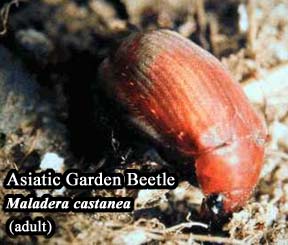 Asiatic garden beetle, Maladera castanea.
Asiatic garden beetle, Maladera castanea.
The grubs of this imported insect feed on the roots of grass and are responsible for considerable injury to lawns. The life history is similar to that of the oriental beetle, but adults fly at night and are attracted to lights. Adults feed at night on many kinds of plants, especially aster, barberry, bean, cherry, chrysanthemum, currant, dahlia, geranium, catalpa, seedling conifers, rhododendrons and strawberries. During the day, the beetles, which hide in the soil around the plants, are seldom seen unless one knows where to find them. The beetle is about 3/8" long, velvety cinnamon brown with a faint iridescence.
Treating the lawns with insecticides described under oriental beetle usually gives effective control. Asiatic garden beetle appears to be the least susceptible of the four common exotic scarabs to imidacloprid, and is not controlled with halofenozide. Trichlorfon provides good control.
Chinch bug, Blissus hirtus.
Dead patches on lawns, although more commonly caused by fungi, are occasionally caused by great numbers of this insect. It is only about 1/7" long, but though small, is conspicuous because it is black and white. It has one generation per year in New England, and is seldom noticed except where damage is observed. These true bugs injure grass by sucking their sap.
Maintaining adequate irrigation and avoiding fungicide application to turf favors fungi that cause diseases in chinch bugs, thus providing adequate biological control. Imidacloprid and insecticidal soap may help suppress chinch bugs.
Corn root webworm, Neodactria caliginosella.
Lawn grass is sometimes injured by this webworm, which feeds in tube-like cases. The larvae of this insect and that of a closely related species occasionally injure corn, especially on sod land, by eating into the side of the stalk just above the surface of the ground. The larva is about 1/2" long and pale white or gray with dark tubercles. Control is rarely necessary.
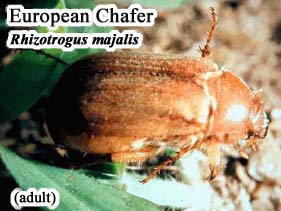 European chafer, Rhizotrogus majalis.
European chafer, Rhizotrogus majalis.
The biology of this white grub is very similar to Asiatic garden beetle. This is the largest species of white grubs, and is especially damaging because it feeds on turf roots later in the fall and earlier in the spring than the other species. Adults are 1/2" long, and are active between mid-June and through July. On warm nights, the adults aggregate around trees or other tall objects, mate, and return to the ground to lay eggs. This behavior often leads to complaints of these beetles falling down chimneys and attempting to burrow under carpeting. This species is fairly difficult to kill with organophosphate or carbamate insecticides, but is especially sensitive to imidacloprid, which is registered in Connecticut for its control. See the comments under oriental beetle for further discussion of treatment options.
Fall armyworm, Spodoptera frugiperda.
Occasionally, lawns are infested by groups of brown-striped caterpillars that devour grass leaves. There are at least two generations here. The insect overwinters as a pupa in the soil. The eggs are laid on the grass leaves; they soon hatch and the larvae feed on the grass, reaching maturity in about a month. They are then about 1 1/2" long and have narrow yellow and brown lengthwise stripes. The first generation of moths emerge in May and June, the second in July and early August, and the third in September. They have a wingspread of about 1 1/4", with forewings grayish brown, and rear wings are pearly white with narrow brownish margins. This insect also feeds on several different kinds of vegetables.
Population densities of cutworms, armyworms, and sod webworms in turf can be determined with an irritant drench. Add one fluid ounce of liquid dishwashing detergent to one gallon of water and pour over a one square yard of turf. Within ten minutes all the caterpillars come to the surface, where they can be counted. More than five armyworms per square yard can justify applying an insecticide. Fluvalinate, spinosad, and carbaryl are among the effective materials registered in Connecticut. Insect pathogenic nematodes, particularly, Steinernema carpocapsae, also will control fall armyworm. Consult the labels for dosage rates and safety precautions.
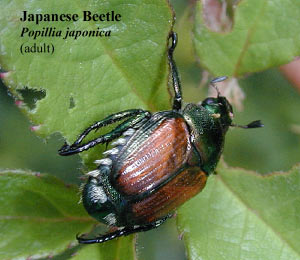 Japanese beetle, Popillia japonica.
Japanese beetle, Popillia japonica.
Adult Japanese beetles have copper colored wings and a metallic green head and thorax. Adults are major pests due to their feeding on rose flowers, grape foliage, and foliage of many other trees and shrubs. Japanese beetle traps containing floral and sex attractant lures are readily available at home and garden centers. These traps may help reduce the overall number of beetles. However, beetles often land and feed on plants close to traps, so traps should be placed well away from valued plantings. The larvae of the Japanese beetle are pests of lawn grass in most areas of the state. Eggs are laid in the grass during July. The larvae feed on grass roots until cold weather, when they burrow down in the ground to overwinter. Feeding resumes after larvae resurface in the spring.
The Japanese beetle, Asiatic garden beetle and oriental beetle all cause the same type of damage to lawns. If the infestation is heavy, spots of the lawn may be killed in August or September. Damaged areas of turf may feel spongy underfoot, and it may be possible to roll the turf back like carpet because of root loss. Vertebrate pests, including skunks, raccoons, foxes, coyotes, crows, and starlings will rip back the turf in search of grubs to eat. White grub infested lawns also are damaged by moles seeking grubs to eat. Treatment of lawns as described under Oriental beetle below will control Japanese beetles.
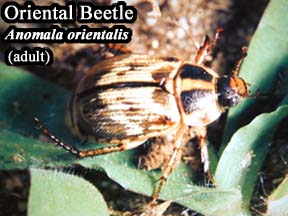 Oriental beetle, Exomala orientalis.
Oriental beetle, Exomala orientalis.
The larvae, or grubs, feed on grass roots just beneath the surface of the ground. The adults emerge in late June and July, and the females lay eggs in the soil, up to a depth of about 6". These eggs hatch 3 to 4 weeks later and the young grubs ascend and feed on the grass roots near the surface. In late October and November, they descend 12" to overwinter. In April, they resurface and resume feeding until the first of June when they go down to a depth of about 6" to pupate. They pass through a prepupal period of about 6 days, then pupate, and 2 weeks later the adults emerge. There is one generation each year, although a few individuals do not transform with the others, therefore requiring 2 years for their development. Adults closely resemble Japanese beetles in shape and size. They are about 3/8" long and vary greatly in color and markings. Some adults have light brown wing covers without markings but a small proportion are uniformly purplish-black. Many of them have black patterns on the wing covers and fall between these two extremes. Most of them have yellowish margins on the thorax with solid black in center, but some have wider margins with the central black area divided lengthwise to form two smaller black areas. The beetles do not fly very much or very far. Adults feed very little, and are occasionally found in rose and hollyhock blossoms.
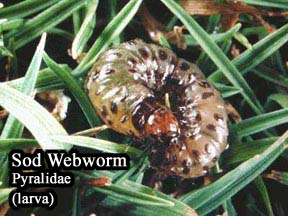 Sod webworms, Crambus and other genera.
Sod webworms, Crambus and other genera.
Small moths flying close to the lawn in short zigzag flights may indicate a population of sod webworms, or lawn moths. These moths have a wingspread of 6/10 to 1". They fold their wings over their back when at rest, and have distinctive mouthparts that stick out in front of their head like a snout. Patches of lawn may become dry-looking and have patchy dead areas. The presence of sod webworm larvae can be confirmed with an irritant drench. Add one fluid ounce of liquid dishwashing detergent to one gallon of water and pour over a one square yard area of turf. Within ten minutes, all caterpillars come to the surface, where they can be counted. A permanent solution for controlling sod webworms is to reseed areas with turf varieties known to contain high levels of endophytic fungi. These beneficial symbiotic fungi produce alkaloids that protect turf from most foliar or crown-feeding insect pests, including sod webworms. More than fifteen sod webworms per square yard can justify applying an insecticide. Fluvalinate, spinosad and carbaryl are among the effective materials registered in Connecticut. Insect pathogenic nematodes, particularly, Steinernema carpocapsae, also will control sod webworms. Consult the labels for dosage rates and safety precautions.

